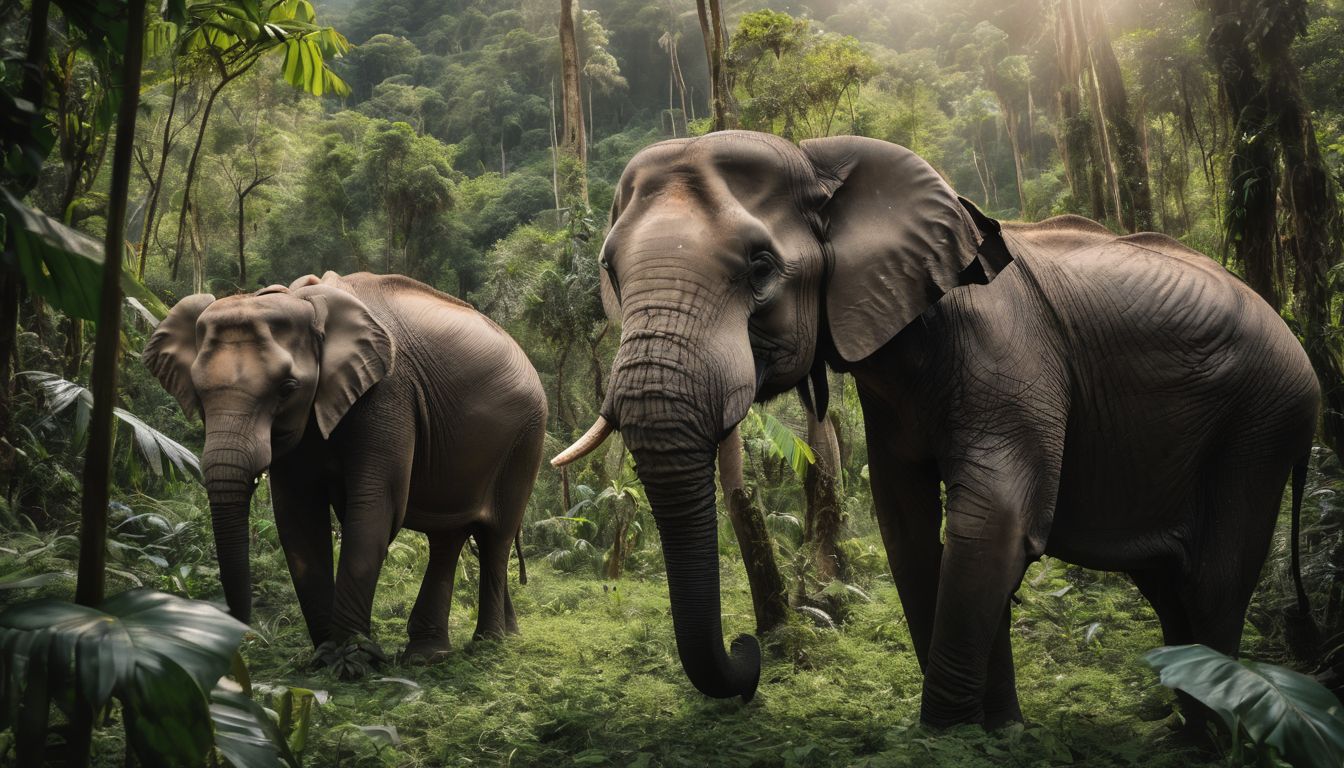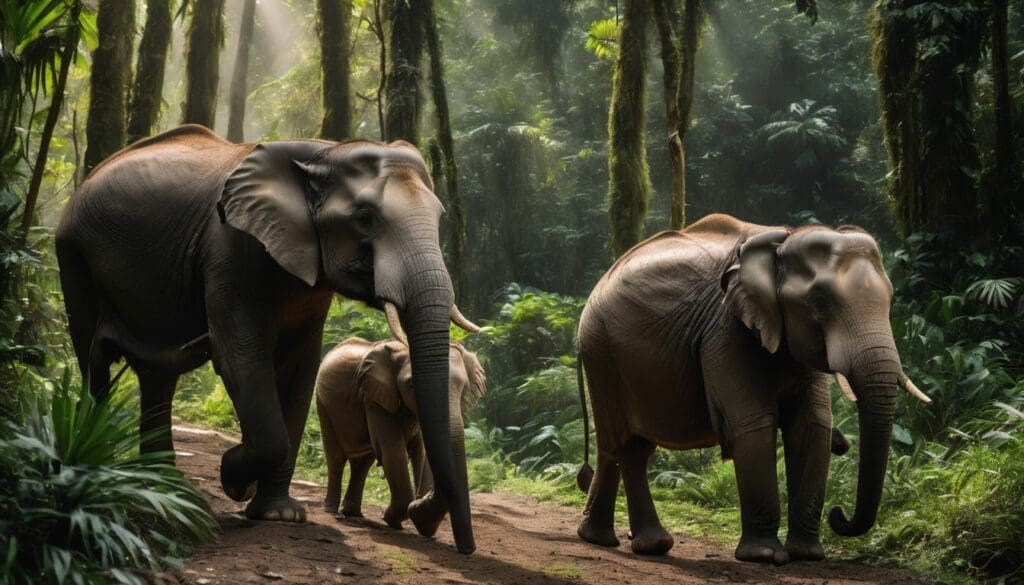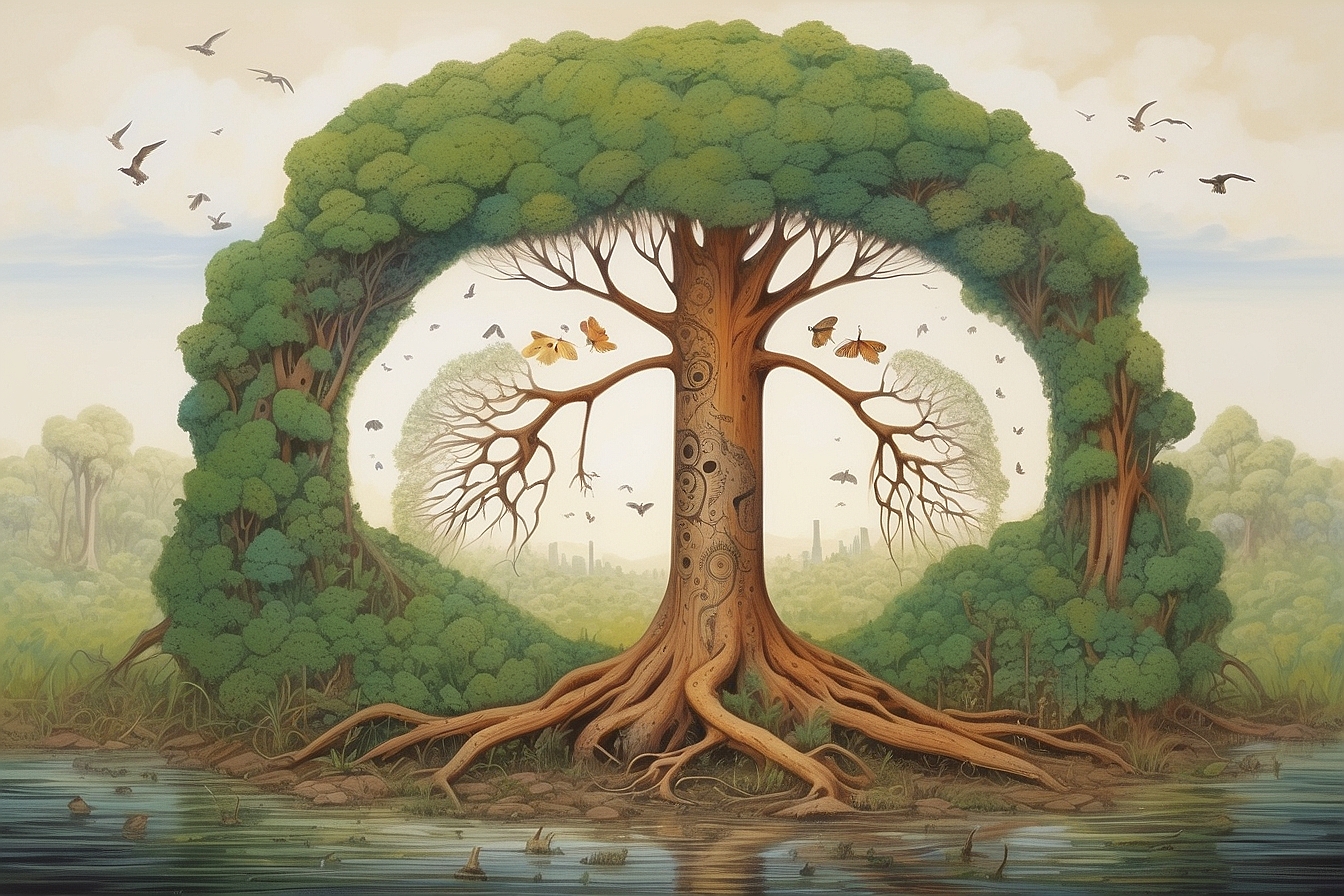As we cast our gaze across the expanse of the Earth, marvelling at the natural wonders she harbours, it is astonishingly easy to bypass the monumental role gentle giants like forest elephants play in moulding their verdant domain.
We share your keen interest – utterly enthralled and committed to peeling back layers of mystery surrounding these majestic creatures. With intriguing research revealing that an African forest elephant can sample over 200 species of plants, our exploration sheds light on their pivotal function as both guardians and architects of our planet’s thriving rainforests.
Do stay tuned; this promises to be a captivating odyssey through nature’s lush tapestry that you surely wouldn’t want to miss!
Key Takeaways
- Elephants are crucial to maintaining biodiversity in rainforests by knocking down trees and trampling underbrush, which leads to the creation of natural clearings for new growth.
- As ‘Ecosystem Engineers’, elephants affect seed dispersal through their diet and dung, aiding plant species diversification and helping with carbon sequestration efforts against climate change.
- Habitat loss and illegal ivory trade pose significant threats to forest elephants, stressing the urgency for stronger conservation actions and international cooperation to safeguard their populations.
- Forest elephants create water sources during dry seasons that other species rely on, highlighting their role in ecosystem sustainability beyond just flora proliferation.
- By acting as ‘Landscape Architects’, elephants shape the physical environment of rainforests ensuring sunlight reaches the forest floor and diverse plants can thrive, supporting a wide range of wildlife species.
The Role of Elephants in the Rainforest

Elephants are vital to the health and biodiversity of rainforest ecosystems, shaping the very environment in which they roam. Their daily activities create a cascade of effects that benefit countless other species.
The Impact on the Environment and Forest Composition
We play a crucial role in maintaining our planet’s biodiversity, and so do African forest elephants. These majestic creatures shape the landscape of rainforests by knocking down trees and trampling underbrush, which creates natural clearings essential for new growth.
Their impressive size allows them to alter forest composition just by moving through it, opening up dense areas that let sunlight reach the forest floor and stimulate diverse plants to grow.
This not only benefits smaller species seeking refuge but also helps maintain the delicate balance of these ecosystems.
These giants are key in seed dispersal; their diet includes fruits and seeds from various plant species that travel vast distances within an elephant’s digestive system before being deposited elsewhere.
Often, these seeds find themselves in fertile ground far away from their parent plant courtesy of their large carriers. Sprouting anew, they contribute to genetic diversity across forests and ensure healthy regeneration over time.
Such activities support carbon sequestration efforts too, since more trees mean more carbon dioxide pulled from the atmosphere—a vital process against climate change challenges we face together.
Seed Dispersal and Landscape Alteration
Elephants are wonder-workers for seed dispersal in the vast rainforests of Africa. Their enormous appetites mean they consume a variety of fruits and vegetation, carrying seeds over long distances.
After digesting them, these giants deposit the seeds in nutrient-rich dung across different areas, helping diverse plant species to flourish far and wide.
Their movements create pathways through dense undergrowth and open up forest clearings known as bais, crucial spaces that alter landscapes dramatically. These natural clearings become hotspots for other wildlife and promote growth of unique plants that thrive in sunlit patches.
As we consider their invaluable role as landscape architects, let’s delve into how elephants contribute to the larger ecosystem as ‘Ecosystem Engineers’.
How Elephants Contribute to the Rainforest Ecosystem

In our trek through the dense tapestry of rainforests, we witness first-hand how elephants are not just inhabitants but vital cogs in these lush ecosystems. Their daily activities sculpt the forest’s very fabric, establishing an intricate balance that supports a myriad of other life forms.
As ‘Ecosystem Engineers’
Elephants play a crucial role in shaping our rainforests, much like engineers transform landscapes. They trample through dense undergrowth, creating pathways for other animals and clearing spaces for new plants to grow.
These mighty animals act as natural bulldozers, uprooting trees and breaking branches, which might seem destructive but actually helps diversify the habitat.
By digging waterholes with their powerful trunks during the dry season, elephants create sources of water that benefit countless other species. Their constant move for food and water sculpts the very earth we walk on, controlling how nutrients are spread across the forest floor.
Their dung is not just waste; it’s packed with seeds from far-off places they’ve visited—seeds that germinate into new life where they fall—a testament to their unsung role in seed dispersal and afforestation efforts within these delicate ecosystems.
We must safeguard these gentle giants whose actions are vital for our rainforests’ health and diversity.
Their Role as ‘Landscape Architects’
Moving from their engineering feats, we see how elephants masterfully shape entire landscapes as well. They act like skilled architects of the wilderness, redesigning the rainforest to suit their—and countless other species’—needs.
By knocking down trees and trampling vegetation, these mighty animals create clearings that let sunlight reach the forest floor. This encourages the growth of a variety of plants that wouldn’t survive in the dense shade.
Their monumental movements through thickets and across streams carve out paths used by other wildlife, ensuring shared access to essential resources. Through this tireless work, they maintain open areas within forests and savannas which are crucial for their own survival but also benefit a host of creatures—from tiny insects to large mammals.
In sculpting their environment so intricately, elephants uphold biodiversity and ensure healthy ecosystems across African countries where they roam free.
Threats to Forest Elephants
4. Threats to Forest Elephants:.
We must acknowledge the mounting pressures forest elephants face, from shrinking habitats that stifle their wandering ways to the voracious ivory trade stripping them of life and lineage.
It’s imperative that we grapple with these challenges not as distant spectators but as active participants in safeguarding these jungle titans.
Habitat Loss
Elephants face a dire threat from habitat loss. Expanding human settlements carve into their roaming grounds. Forests shrink and fragmentation occurs, leaving less space for these magnificent creatures to live and feed.
This forces elephants closer to human communities, often sparking conflicts as they search for food.
Our conservation efforts need to focus on protecting the places elephants call home. It’s crucial we preserve wilderness areas not only within national parks but also in wildlife corridors that connect them.
We must fight against deforestation and degradation of natural habitats. Every patch of forest saved is a step towards ensuring African elephants have a future free from the fear of losing their homes.
Illegal Ivory Trade
We must confront the grim reality of the illegal ivory trade, a dark shadow over conservation efforts. This merciless business fuels the slaughter of elephants for their tusks, devastating populations across Africa and Asia.
Ruthless poachers target these majestic creatures, often in protected areas where they should be safe. The demand for ivory keeps prices high on the black market, making it a lucrative but deadly venture.
As we fight to protect our elephant populations, including both Loxodonta africana and Elephas maximus bengalensis, it’s crucial to shut down ivory markets worldwide. International laws under CITES aim to regulate this trade; however, enforcement remains challenging due to corruption and inadequate resources.
Strides are being made as some countries have banned domestic ivory sales altogether—a testament to what we can achieve through collective action against this unethical trade that threatens an irreplaceable keystone species with extinction.
Conclusion
In wrapping up, let’s recognise that forest elephants are vital to the health and diversity of rainforests. These majestic creatures shape ecosystems, but their survival hangs in balance due to human actions.
Protecting them is not just about saving a single species; it’s about preserving the rich tapestry of life they support. Every effort counts towards ensuring these jungle giants continue to thrive in their natural habitat for generations to come.
Their fate and ours are deeply intertwined within the delicate web of our planet’s biodiversity.
FAQs
1. Why are elephants important to rainforests?
Elephants play a crucial role in rainforests by helping with carbon storage, spreading seeds through browsing, and maintaining the ecosystem’s balance.
2. What is causing population decline in forest elephants?
Forest elephant numbers are dropping primarily due to habitat destruction, illegal wildlife trade, including the trade of elephant ivory, and human-elephant conflicts.
3. How can we prevent human-elephant conflict?
To minimise human-elephant conflicts efforts include setting up conservation areas, promoting wildlife management strategies like translocation, and supporting habitat restoration projects.
4. Are all elephants endangered?
Yes, both African savanna elephants (Loxodonta africana) and forested cousins Loxodonta cyclotis along with Asian Elephants (Elephas maximus) fall on the IUCN Red List as threatened or endangered species.
5. What do organisations like the Wildlife Conservation Society do to help elephants?
The Wildlife Conservation Society works globally to protect mammalian species such as elephants by advocating for laws against the illegal wildlife trade and conducting research like the Great Elephant Census.
6. Can international agreements help save the elephants?
Indeed! The Convention on International Trade in Endangered Species helps safeguard animals such as savannah and forest elephants from over-exploitation through global cooperation.





